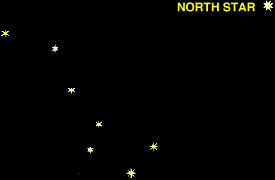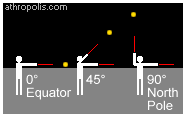
 The North Star - Nature's Compass The North Star (also called Polaris, polar star and polestar) never changes its place in the sky. When you face it, you are always facing North. To find the North Star, first find the Big Dipper. Draw a straight line through the two pointer stars that make up the end of the dipper's bowl and continue this line away from the opening of the bowl until it intersects with Polaris. Between the Equator and the North Pole, the angle of Polaris above the horizon is a direct measure of latitude.
Look at the North Star and point one arm straight at it, and then hold your other arm level with the horizon. The angle between your arms is roughly the degrees of latitude of your location (For example: 45°). Simple, huh?
Click pictures for more information and credits. Library: Arctic, Sky/Seasons Links: Arctic, Constellations Arctic Maps & Weather Reports Moon Phases |

|
DICTIONARY: Just "double-click" any unlinked word on this page for the definition from Merriam-Webster's Student Electronic Dictionary at Word Central. |

|
ARCTIC LIBRARY & GLOSSARY: Check this section for an index of the rest of the things you really need to know about the Arctic. |

|
ARCTIC MAPS & WEATHER REPORTS: Maps of the Northwest Passage, explorers' routes, iceberg sources, Nunavut, the Arctic by treeline, temperature... |

|
ARCTIC LINKS: Even more information! Links to sites related to the Arctic and "Iceberg: the Story of the Throps and the Squallhoots". |

|
GUIDE TO ARCTIC SUNRISE & SUNSET: How much sunlight or darkness is there in the Arctic on each day of the year? |
to is the property of their respective owners, and Athropolis is not responsible for their content.
